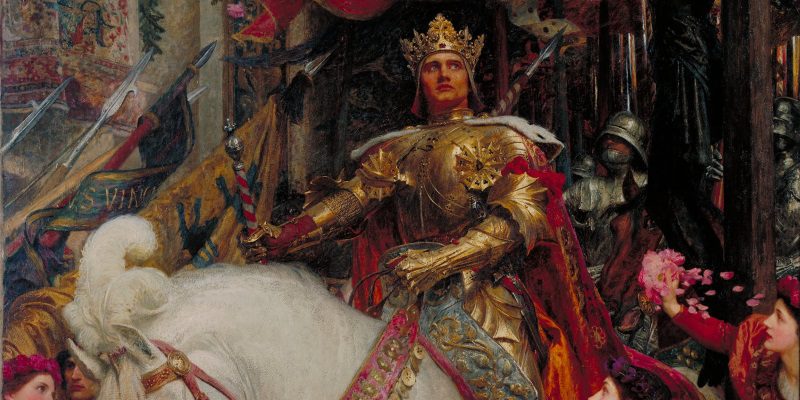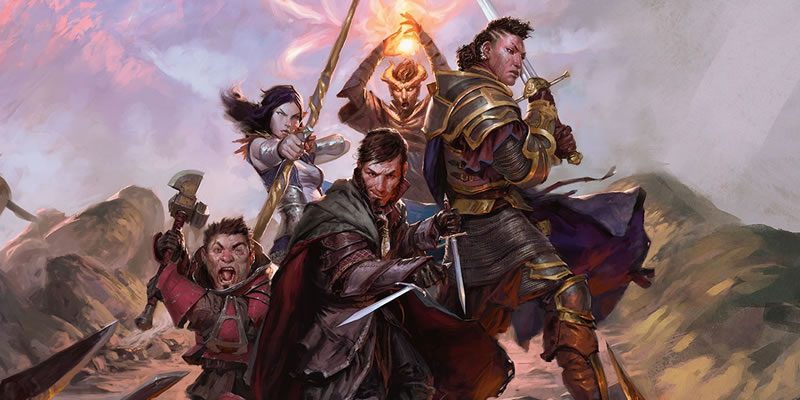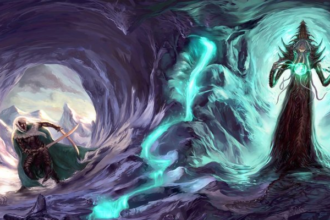The Paladin Class, Part Five

Welcome back! Last time in History of the Classes, I talked about the Paladin and Blackguard classes of 3.0 and 3.5. This time, we’re diving into the 4e and 4e Essentials, though my text reference for 4e Essentials is a wiki and I’m a lot less clear on how it all comes together. Someone with a copy of Heroes of the Forgotten Kingdoms could really do me a solid, I’m just sayin’.
Also, I know it greaves you, but paladin puns are srs bidness. Which is to say, really hard to come up with.
(Part One, Part Two, Part Three, Part Four)
In the class role and power source breakdown of 4e, the Paladin is the Divine-sourced defender. This builds on the new concepts of the 3.x Paladin rather oddly, as the 3.5 Paladin had enough Smite Evil uses per day, as well as some solid spell options, to branch out of the defender role in a party. In 4e, there’s no striker-ness to be found – Paladins do reasonable damage, but no more than you’d expect for any defender who dabbled in the leader role.
Their core game loop is about the same as any other defender, except that their mark does a fixed amount of radiant damage, rather than granting the defender an attack; it also works at a range, as long as the paladin doesn’t stop trying to engage that target. (This involved a published correction to address an abuse.) As all of the 4e PHB Paladin powers are prayers, by definition, there’s a flashy light show in the description of just about every power. This made me obscurely uncomfortable – this is how I discovered that I care about the Paladin class theme being mostly warrior with some divine aspects, rather than a divine character who behaves a little like a warrior. It’s only a little rein on my parade.
If you’ve read every article in this series, you know I don’t like to stirrup trouble, but design of ages past deserves an honest critique with the benefit of hindsight. As presented in the Player’s Handbook, the 4e Paladin has one bad problem, which it shares with the Cleric and the Warlock: split-stat dependency. Roughly half of the attack powers use one ability score for attack and damage values, and the rest use another. For the Paladin, the split is between Strength and Charisma. On its face, this seems like it would be fine – isn’t it pretty cool to have two different visions of a class presented together, and to offer that much variation of characters within a single class? The answer, unfortunately, is that it doesn’t work. In 4e, the attack accuracy curve is punishing enough that you don’t want to be saddled with anything less than an 18 in your primary attack stat. Given that point-buy is the default ability score generation method, there’s really no way to start with two 18s, so one of your stats is always going to fall short. In turn, this means that half of your class’s powers feel closed to you, and the initial-release Paladin had no Strength-side options at 9th level.
Note: This isn’t the same as classes needing two or three different secondary stats. You can absolutely get valid, satisfying use out of a power for which you have a poor-to-middlin’ secondary stat. I believe that this kind of stat crunching drove people away from 4e, overall.
Now that I’ve covered that, let’s get to what’s good here, because the class does have some style.
- Paladins are the only 4e class to start play with plate armor proficiency, granting them a superior starting AC if they also use a shield.
- They also receive the largest base number of healing surges per day, though I doubt that many paladins had a high ability score left to throw into Constitution. This is important for their Lay on Hands class feature, below.
- Two Channel Divinity options: Divine Mettle makes them a status-effect cuirass (that’s kyo͝orˈas; the other pronunciation doesn’t make my little play on words work, ah-ha, ha-ha) with an extra saving throw, while Divine Strength grants some extra damage for Strength paladins (especially important if they’ve had to purchase Charisma-based powers).
- I mentioned Divine Challenge, the core Paladin marking mechanic, in passing before. Its core down side is that paladins have a tough time “tanking” more than one target at a time. By comparison, a fighter who is willing to blow all of his encounter and daily abilities can probably keep two or more targets marked long enough for his allies to put down at least one of them. New powers in the Divine Power splatbook address this shortcoming, though it can be a bit complicated and, for established characters, it means a lot of retraining.
- Lay on Hands, of course! It’s literally the only class feature that shows up in every edition of this article series. Unlike most other healing sources, Lay on Hands allows the paladin to spend their healing surges, while the target gains the hit points. Since daily usage of Lay on Hands is linked to Wisdom, and daily availability of healing surges is linked to Constitution, paladins need at least some degree of bonus in four ability scores. Good luck!
- I should really throw in a bonus article at the end with the Rules Cyclopedia of OD&D, Pathfinder, and 13th Age, because they’re all doing their own thing and some of the sacred cows of the class are, indeed, put out to pasture.
- Notable absence: No reference of any kind to a mount.
As with other 4e classes, I’ll have to beg off of examining each individual power – it would take an already long article and doublet. There’s a pretty standard variety of powers, all pretty tightly themed on “magical warrior with a magical martyr complex (that actually works).” The magical side lets them justify a much wider variety of effects than martial classes have going on, at least. It feels a little weirder to me that these paladins have teleportation, angels showing up, and astral-related effects, but they’re in keeping with the flashy high-magic tone of 4e.
Charisma-based attacks are especially likely to be ranged or area effects, which creates an interesting situation: because they’re so heavily themed as spellcasting, you really can play a defender who spends a lot of time at range. In 3.x or 5e, you would probably build that character as a Cleric rather than a Paladin, but here that concept firmly belongs within the Paladin class for access to defender features.
Divine Power
The Avenging and Protecting Paladins of the Player’s Handbook are thematically “the wrathful one” and “the martyr,” and Divine Power adds the almost-a-striker one (Ardent) and the one that shrugs off hostile magic (Virtuous). As character themes, these are maybe a little harder to differentiate – Ardent seems like an alternate Avenging, but with a damage kicker that replaces Lay on Hands; Virtuous seems like an alternate Protecting, again losing Lay on Hands. As much as I like 4e, I feel like this is a place where they’ve ditched theme and characterization completely in favor of flashy new mechanics.
The mechanics do one really important thing, though: they introduce Divine Sanction, which is a lesser and shorter-duration Divine Challenge, but various combinations of powers let you toss out your Divine Sanction pretty widely. There’s also an increasing inclusion of effects that feel most like a warlord, such as Glorious Charge.
Especially with the inclusion of Divine Power, I think the Paladin becomes an object lesson in best-practices 4e DMing. The powers have their own theme, but they leave a lot of blanks. Take Name of Might’s flavor text as an example: “You shout an ancient angelic name of thunderous power that slows your foes.” It’s easy to skate on by and treat it as common, because everyone who isn’t Martial-sourced has powers a lot like this. You have to bring your own richness in the details. When the paladin advances to 5th level and learns Name of Might, give her a quick solo scene in which she has an overnight vigil in a chapel and speaks with the angel whose name she is learning, perhaps making an additional oath to that angel that affects her roleplay going forward. This is something I failed to do in my own 4e games, having come to a clear understanding of it only after my last 4e campaign ended. It’s a good idea in 5e as well, but perhaps a bit less urgently so.
4e Essentials: The Cavalier
Heroes of the Forgotten Kingdoms introduced the Essentials Paladin, with a build called the Cavalier. The Cavalier is distinct from the PHB Paladin more in mechanics than theme, as they rely more on modified basic attacks than the at-will/encounter/daily breakdown of original 4e. The Cavalier does a lot of things that fit recognizably with 5e, but because they’re using the design language of 4e, it can be really complicated to explain some relatively simple things.
They have a power called defender aura, common (I think) to all Essentials defenders. This doesn’t mean they actually have a glowing aura around them that makes them defenders (unless you really want); it’s just that this is 4e’s terminology for how defenders lock down the area within their reach. A second power, righteous radiance, keys off of defender aura to replace Divine Challenge. It’s an opportunity action on the part of the paladin rather than a condition placed on the enemy, so it solves for the issue of Challenge-and-withdraw, but if the enemy can find any way to not be adjacent to the paladin that doesn’t involve a move or a shift (such as forced movement or teleportation), they’re fine. As with Divine Challenge, it has the advantage over other defender classes that it doesn’t have to roll to hit, but it also can’t spike damage nearly as high as even a melee basic attack. As radiant damage, basically nothing is immune and very few things are resistant, while undead are vulnerable to some degree. As an opportunity action, it means that a dazed paladin is a non-defending paladin – a step down compared to the PHB Paladin, and putting them on an equal footing with every other defender ever.
There’s a smiting power that’s a very nice damage boost once per encounter, and a power that redirects damage from an ally to you and gives you a short-term attack boost. All pretty much fine.
You choose a Virtue, either Sacrifice or Valor, and gain both a class feature and an at-will attack from it. One is only for Lawful Good paladins, while the other is for any non-evil paladins. (There’s a different build, the Blackguard, if you can’t meet the “any non-evil” requirement.) Overall, Valor works out to parallel Avenging/Ardent, and Sacrifice works out to parallel Protecting. I don’t see anything especially matching up to Virtuous, but the functions of Virtuous aren’t central themes to the Paladin class, unless you look all the way back to the OD&D/1e holy sword abilities.
Some of the later powers bring mounts back into gameplay, and let me just say it would be a damn sad cavalier who didn’t have some power relating to mounts. As in D&D 3.5, the paladin’s mount is a magically appearing and disappearing creature, which is an easy handwave to solve a lot of the dungeon-delving problems that result from having a bonded mount. It does draw a lot of Pokémon references, though… maybe most famously, Order of the Stick.
My one real regret with the Cavalier, overall, is that it doesn’t include social-interaction features, as the Bard did; everything I’m seeing here is combat-related. 4e doesn’t have to be like this, no matter what its detractors claim.
The Blackguard
Heroes of Shadow (Adventuring For Villains!) brings us the Blackguard as a build of Paladin, turned much more toward Striker rather than Defender. Apparently, evil doesn’t defend, because of the four classes and three alternate builds in this book, there are no defenders. I guess WotC’s idea of evil doesn’t allow for someone who deliberately acts as the party’s meat shield, even though it’s mostly about punishing people for contradicting your manifest will. Since the class is still a paladin under all that sinister angst, they can still get to some of that defender-ness through feat and power selection.
Anyway, the Blackguard build is fine for playing an antihero on a path of either conquest (Vice of Domination) or annihilation (Vice of Fury). It wouldn’t be my thing; the names of things are more or less cartoonishly evil. I appreciate that they wanted to support people who love Death Knights in World of Warcraft, but it seems to me that the themes WotC plays with are rather narrower than the ones Blizzard draws upon. The Blackguard kind of comes down to, “I’m so angry all the time, grr, argh.” Mechanically, I expect that they’re a lot of fun to play, because they beat things to death with keenness and speed. Even more than other 4e paladins, blackguards embody the code of shivalry: not just murderhoboes, but murderhoboes on a crusade.
Conclusion
Because of how multi-classing works in 4e, I wouldn’t recommend trying to cobble together a Paladin out of a Fighter with Cleric dabbling, or the other way around, though I guess it might work. I don’t really know, and it would be miserably complicated to work out the details. Thematically, it would probably be rock-solid, but mechanically it might have issues, especially on the uses-per-day front. Hybrid-style multi-classing is probably your best bet. Cleric does have plenty of Strength powers, though, and you could completely dump the Paladin’s need for a good Charisma. I dunno, Runepriest (PH3) might be a better combo – I had a player hybridize the Runepriest with the Barbarian, to impressive effect.
The 4e Paladin, in its several iterations, doesn’t seem to make any lasting changes to the themes represented in the class, because it stays within some quite narrow lines. The 5e Paladin, on the other hand, ransacks two other 4e classes for genetic material: the Warden (the Primal-source defender) and the Avenger (the Divine-source striker), really breaking out of the shell for practically the first time in the class’s history. I would like to see an alternate vision of the 5e Paladin that borrowed 4e’s emphasis on interaction with angels, power derived from the Astral Plane, and the like. In fact, I know of one really cool fan-created one. It blurs the line into The Seventh Sea considerably, but all of 4e’s flavor-text references to high and secret knowledge of the Divine (in Cleric, Invoker, and Avenger as well as Paladin) suggests to me the idea of running a campaign in which the PCs are Rosicrucians with actual powers, in a world that is otherwise entirely ignorant of magic. That would probably be amazing.
To everyone who came for the puns, I hope you stayed for the commentary, because even if I was champion at the bit to bring you the finest, freshest puns from my crop, instead you’ve mostly been waiting all knight.
…
I am so ashamed.



